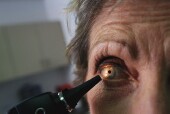
FRIDAY, May 24 (HealthDay News) — Drugs commonly used to treat glaucoma may cause droopy eyelids and other side effects that can interfere with vision, according to a new study.
The drugs, known as prostaglandin analogues (PGAs), which are used to reduce eye pressure, have already been shown to cause blurred vision, dryness and changes in eye color, the researchers said, suggesting that the new findings could lead to labeling changes for PGAs.
Doctors should be conservative when prescribing these drugs, the researchers added, particularly as a preventive measure for patients at risk for glaucoma.
“The loss of periorbital fat was previously described by us in a small series of unilateral PGA users,” senior study author Dr. Louis Pasquale, director of the glaucoma service at the Massachusetts Eye and Ear Infirmary, said in an infirmary news release. “Those observations did ultimately lead to a change in drug labeling. These new findings could change labeling for the PGAs, as upper lid [drooping] could aggravate pre-existing visual-field loss.”
The study, led by Dr. Mamta Shah, a medical student at Boston University School of Medicine, analyzed 186 women and 157 men over the course of seven months in 2011. Researchers took into account any other glaucoma medications the patients were taking, along with other factors to determine whether PGAs alone caused certain side effects.
They found that PGA use in both eyes was associated with deepened upper eyelid furrows, hollowing of the inferior fat pads in the skin around the eye, droopy upper eyelids with abnormalities in certain muscles around the eye and lower lid retraction.
“Because PGAs are a first line of treatment for glaucoma, these results provide physicians with one reason to reconsider when they should be added in new patients, particularly those where the aim is to prevent glaucoma — such as in ocular hypertension patients or glaucoma suspects,” said Pasquale, who also is an associate professor of ophthalmology at Harvard Medical School in Boston.
The study was published May 1 in the journal PLoS ONE.
More information
The U.S. National Eye Institute has more about glaucoma treatments and their side effects.

